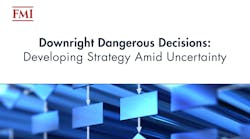FMI Corp. released two related publications April 1: “Downright Dangerous Decisions: Developing Strategy Amid Uncertainty,” which outlines seven points to help construction company owners and managers organize their business approaches to this health crisis and resulting economic challenges; and the “First Quarter 2020 North American Engineering and Construction Outlook.”
In the strategy article, FMI’s economists share a range of possible outcomes much like you would see in a hurricane tracking map (i.e., cone of uncertainty). These outcomes are summarized in three scenarios as follows:
- Current assumed trajectory. FMI’s current assumed trajectory (as presented in the Q1 2020 Outlook) assumes two quarters of negative GDP growth (i.e., Q2 and Q3), ending the year between zero and 1 percent. This triggers an official recession.
- Extended economic disruption. The extended economic disruption line assumes three quarters of negative GDP growth (i.e., through Q4 2020). Economic recovery would not occur prior to the presidential election.
- Disruption to disintegration. This scenario assumes a minimum of six quarters of negative GDP growth (through Q2 2021) and would be equivalent to that of the Great Recession (i.e., December 2007-June 2009). Significant financial collapse must occur under this scenario.
To access the “Downright Dangerous Decisions” article, click here.
It is important to note that the Q1 2020 Outlook represents a best-case scenario that considers several, but not all, of the ongoing market dynamics.
Based on the speed and breadth of current socioeconomic disruptions, FMI is anticipating, at minimum, a recession spanning the second and third quarters of 2020. Depth and reach of these disruptions will remain under watch through the coming months, and FMI’s economists will be providing more frequent updates on their industry forecasts in the coming weeks.
To access the Q1 2020 Outlook, click here.








